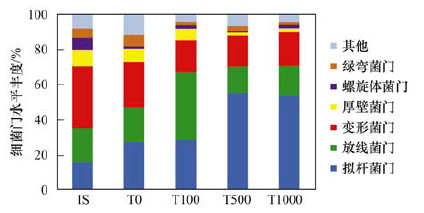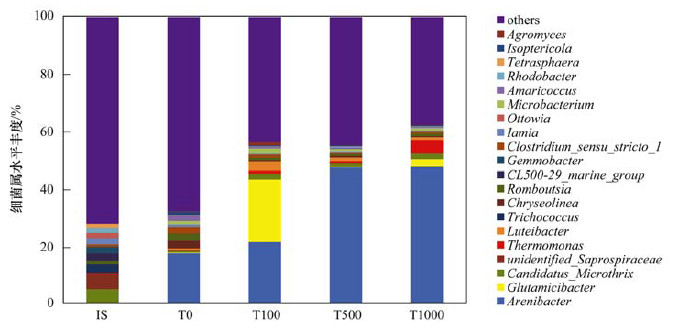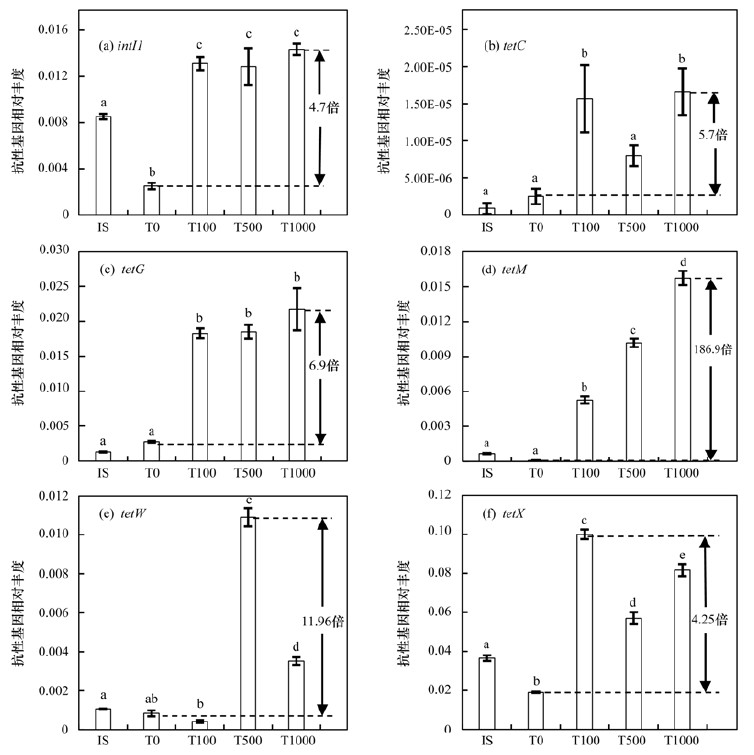抗生素被广泛使用在医疗和养殖业中[1, 2].据统计, 2013年我国抗生素的使用量达到了16.2万t[3], 但约有75%的抗生素未被有效吸收, 会以原药的形式代谢到环境中[4].环境中残留大量的抗生素导致了诸多携带抗性基因的耐药菌出现, 对人类的健康带来了潜在的危害[5].抗生素及其抗性基因经市政管道流入污水处理厂, 最终汇集在城市污泥中[6].已有检测表明脱水污泥中存在多种高丰度的抗性基因, 主要有四环素类、喹诺酮类、磺胺类等[7~9].抗性基因作为一种新型污染物, 其潜在的环境风险比抗生素本身更大[10].相关学者对污泥中抗性基因的消减进行了研究.结果表明无论是厌氧消化还是高温堆肥, 对抗性基因的消减均是选择性的, 仅有少部分抗性基因可以被完全去除[11~13].因此, 污泥资源化同时降低抗性基因风险已成为亟待解决的课题.
蚯蚓堆肥是利用蚯蚓和微生物的协同作用将污泥中的有机质分解转化的过程[14], 其主要包括蚯蚓肠道的消化过程和微生物的分解过程[15].与其他方法相比, 蚯蚓能显著提升污泥中有效态的氮磷钾等元素的含量以及多元降解菌和农业益生菌群等功能化菌群的多样性[16~19], 因此蚯蚓堆肥被认为是一种有竞争力的污泥资源化方法.但问题是由于污泥中存在每日变化的高含量抗生素, 可能会影响功能性菌群, 进而影响污泥蚯蚓堆肥产物的性质.并且, 污泥中抗生素含量对抗性基因有一定的选择性压力[20, 21], 也会增加污泥蚯蚓粪抗性基因的传播风险.基于此, 研究四环素含量对污泥蚯蚓粪中微生物及其抗性基因的影响, 对增加污泥蚯蚓粪的利用价值和控制抗性基因的传播是至关重要的.然而, 对此研究目前还鲜见报道.
本实验以城市污泥中含量较多的四环素作为供试抗生素[22], 以不添加四环素为对照组, 添加不同含量四环素为实验组, 比较四环素含量对蚯蚓堆肥产物中微生物种群结构和抗性基因丰度的差异, 以期为提高污泥蚯蚓粪的利用价值和控制四环素抗性基因及其传播提供科学依据.
1 材料与方法 1.1 供试材料本实验采用经过新鲜污泥驯化的赤子爱胜蚓(Eisenia foetida)作为堆肥蚓种, 单体重约为0.4 g.反应器为底部打孔的矩形塑料盒(46 cm×17 cm×13 cm).污泥取自兰州市安宁七里河污水处理厂脱泥车间的新鲜脱水污泥.
1.2 实验方法所得新鲜污泥利用5 mm网孔的铁丝网进行造粒.然后将0、400、2 000和4 000 mg的四环素粉末(分析纯, 99.9%; Ruibio, Germany)分别加入到4 kg造粒污泥中.将四环素和污泥充分混匀后, 对其再次造粒, 作为蚯蚓的供试基质.然后在各反应器中接种100条蚯蚓, 开始蚯蚓堆肥实验, 其投加密度参照文献[18]的实验进行.本实验中, 将4组不同四环素含量为0、100、500和1 000 mg·kg-1分别标记成T0、T100、T500和T1000, 每组均设3个平行反应器.为保持水分和湿度, 所有反应器用带孔的保鲜膜覆盖, 一周喷洒一次自来水并翻堆一次.60 d后, 取出蚯蚓和蚯蚓处理后的样品.每个反应器样品分两组保存, 一组干燥后研磨, 然后过60目筛, 置于4℃冰箱保存; 另一组置于-20℃冰箱中冷冻保存.
1.3 测试方法 1.3.1 理化指标将风干样品与去离子水混匀(干样:水=1 :50; kg·L-1), 磁力搅拌30 min后, 测定pH值(PHS-3C, 雷磁).将风干样品与超纯水混匀(干样:水=1 :50; kg·L-1), 将上述混合液稀释10倍后, 过0.45 μm滤膜, 用TOC仪(Shimadzu, Japan)测定样品的溶解性有机碳.总碳和总氮采用元素分析仪(Yanaco CHN CORDER MT-6, Japan)进行测定.
1.3.2 DNA提取和高通量荧光定量PCR将每组的平行样品混合后, 利用DNeasy® PowerSoil® Kit(QIAGEN, Germany)试剂盒提取总DNA, 然后用1%的琼脂糖电泳进行浓度检测.
本实验选择两种外排泵基因(tetC、tetG)、两种核糖体保护基因(tetM、tetW)、一种酶失活基因(tetX)及一种整合子基因(intI1)进行检测.利用高通量荧光定量PCR进行相对定量检测(Applied Biosystems, ViiA® 7, USA; 上海启因生物技术有限公司).使用的引物与Huang等[23]一致, 采用FastStart Universal SYBR Green Master(ROX, Roche, USA)作为荧光染料.两步qPCR反应条件为:95℃预变性10 min; 40个循环包括95℃变性30 s, 60℃延伸30 s.
1.3.3 高通量测序采用带有Barcode信息的引物341F(5′-CCTAYGGGRBGCASCAG-3′)和806R(5′-GGACTACNNGGGTATCTAAT-3′)对细菌16S rDNA的V3~V4区进行扩增.高保真酶Phusion® High-Fidelity PCR Master Mix (New England Biolabs)被用于PCR反应.所得到的PCR产物用2%的琼脂糖电泳进行检测.然后使用GeneJET胶回收试剂盒(Thermo Scientific, USA)纯化.利用Ion Plus Fragment Library Kit 48 rxns建库试剂盒(Thermofisher, USA)建立测序文库.利用Qubit® 2.0 Fluorometer (Thermo Scientific, USA)对其进行检测.合格后在Life Ion S5TM测序平台(诺禾致源生物信息科技有限公司)上进行测序.对于结果中低质量部分采用Cutadapt软件进行剪切, 然后将序列与UCHIME Algorithm和数据库Gold database进行对比, 得出最终的基因序列.
1.4 统计方法采用Statistica 10统计软件对pH、溶解性有机碳、总碳、总氮、抗性基因丰度在各组间的差异进行one way ANOVA分析(Hsd-test), 本实验显著性水平为0.05.
1.5 物种多样性计算本实验以科水平来对生物多样性进行分析, 使用公式(1)计算Shannon指数, 公式(2)计算Pielou指数[24].

|
(1) |

|
(2) |
式中, S为群落中所有物种数目; N为群落中所有个体数目; ni为群落中第i个物种的个体数量; H′为香农指数, J为Pielou指数.
2 结果与讨论 2.1 四环素含量对理化性质的影响由表 1可知, 与新鲜污泥相比, 各组蚯蚓处理产物中pH均显著降低(P < 0.05), 其中T0组的pH值最低.与T0相比, T100、T500和T1000组pH值均略有增加, 最大值出现在T100组.这一结果说明添加四环素对污泥蚯蚓粪中的pH有一定的影响.实验后, 各组污泥蚯蚓粪中总碳显著降低了55.7%~58.8%(P < 0.05).与T0相比, T100组总碳含量略有降低, 而T500和T1000组略有升高, 并且添加四环素与无添加之间无显著性差异(P>0.05).同时溶解性有机碳也呈现出与总碳相近的变化趋势.对总氮而言, 与新鲜污泥相比, 添加四环素的污泥蚯蚓堆肥产物中显著下降了76.3%~77.9%, 最低值出现在T100组.并且添加四环素组与无添加组相比均无显著差异(P>0.05), 说明四环素的添加对总氮含量无显著影响(P>0.05).本研究中四环素的添加对碳、氮含量变化都无显著性影响, 可推测其对有机质的降解亦无显著影响.王桂珍等[25]利用鸡粪进行高温堆肥后, 抗生素对有机物的降解无明显的影响.但是郭梦婷等[26]利用猪粪进行高温堆肥后发现高含量(150 mg·kg-1)的抗生素会抑制微生物对氮的分解.而本研究中1 000 mg·kg-1的四环素对总氮仍无影响, 可能是由于蚯蚓的存在能够将部分含量的抗生素吸收或是分解, 致使其对微生物的影响减弱.
|
|
表 1 蚯蚓堆肥前后污泥理化性质的变化1)/mg·g-1 Table 1 Changes in physicochemical properties of sludge before and after vermicomposting/mg·g-1 |
另外, pH最高值, 总碳和总氮的最低值都出现在T100组, 这一原因可能与蚯蚓的生物量有关.因为在实验过程中发现T100组中蚯蚓的生长状态最好.相关资料表明低含量四环素可作为动物助长剂[27]; 因此100 mg·kg-1四环素含量促进了蚯蚓生长, 进而激发了微生物的活性和数量, 加速了碳氮的分解.
2.2 四环素含量对微生物种群的影响Shannon指数表示微生物种群多样性的高低, Pielou指数代表微生物种群均匀度的大小.由表 2可知, 与T0组相比, 随着加入四环素含量的升高, 微生物种群的多样性和均匀度都呈现出较强的负相关关系.这说明四环素对微生物的多样性和均匀度均有显著的抑制作用.人畜粪便好氧堆肥的过程中也发现随着四环素含量的增加, 生物多样性指数呈现下降的趋势[28].
|
|
表 2 新鲜污泥及堆肥产物中微生物Shannon指数和Pielou指数 Table 2 Microbial indexes of Shannon and Pielou in fresh sludge and vermicomposting products |
图 1为蚯蚓堆肥前后细菌门水平的变化, 新鲜污泥中优势种群主要有变形菌门(35%)、放线菌门(19%)、拟杆菌门(16%)和厚壁菌门(10%).污泥蚯蚓粪T0组中优势种群为拟杆菌门(27%)、变形菌门(26%)和放线菌门(20%).与T0组相比, 添加四环素组中的拟杆菌门均有增加, 在T500组表现出最大的增加.有学者在高温堆肥中也发现添加四环素含量为500 mg·kg-1时也含有大量的拟杆菌门[28].拟杆菌群是大分子有机物的主要降解者[29], 四环素组中高丰度的拟杆菌群暗示其处理中可能存在诸多大分子有机物未被降解.对放线菌门而言, 其丰度与T0组相比, 在T100组升高了1.97倍, 但是在T500和T1000组分别减小了0.77倍和0.87倍.这可能是因为蚯蚓在T100组的生长状态较好, 蚯蚓的排泄物中放线菌的含量较高所导致的[30].Huang等[31]检测到蔬菜蚯蚓堆肥产物中放线菌的数量达到了1010copies·g-1.另外, 变形菌门在T0、T100、T500和T1000的丰度分别为26%、18%、18%和19%, 说明添加四环素会抑制变形菌门丰度, 且这种抑制与其剂量无关.

|
IS代表新鲜污泥, T0、T100、T500和T1000分别代表污泥中四环素含量为0、100、500和1 000 mg·kg-1, 下同 图 1 蚯蚓堆肥前后污泥中细菌种群门水平结构变化 Fig. 1 Changes in the bacterial community structure of sludge before and after vermicomposting at the phylum level |
图 2表示蚯蚓堆肥前后微生物种群属水平的变化.新鲜污泥中优势菌属为Candidatus_Microthrix(5%)和unidentified_Saprospiraceae(5%).蚯蚓处理后, 添加四环素实验组的蚯蚓粪中Arenibacter的丰度比T0组增加了1.26~2.66倍.Arenibacter是一种可以降解多环芳烃的细菌[32].高丰度的Arenibacter出现在高含量四环素组可能和四环素降解的过程中产生大量的多环芳烃类物质有关.Glutamicibacter是属于放线菌门中的一类微生物[33], 是一种农业益生菌, 其大量存在, 对于污泥蚯蚓堆肥产物的农用起到良好的促进作用[34].Glutamicibacter在T100组的丰度极高可能是由于蚯蚓的活性较好所致.

|
图 2 蚯蚓堆肥前后细菌种群属水平结构变化 Fig. 2 Changes in the bacterial community structure of sludge before and after vermicomposting at the genus level |
由图 3(a)可知, 与新鲜污泥相比, T0组的intI1基因丰度显著降低了0.7倍(P < 0.05).与T0组相比, 添加抗生素的处理组中intI1 基因丰度显著增高了5.1~5.7倍(P < 0.05), 但T100、T500和T1000这3组之间无显著性差异(P>0.05).表明尽管添加了较低的四环素含量,但仍会使污泥蚯蚓粪中intI1基因的丰度增加.intI1 基因是整合子基因, 是抗性基因传播的载体.在添加四环素后, 四环素对细菌产生选择性压力, 使intI1 基因丰度增加, 从而导致细菌中抗性基因的丰度增加[35].在蚯蚓堆肥后intI1 基因丰度的显著降低, 证明了蚯蚓堆肥可以抑制整合子的丰度, 控制抗性基因的传播.这与之前的研究结果一致[23, 36].

|
图 3 蚯蚓堆肥前后污泥中intI1 基因与四环素抗性基因的相对丰度 Fig. 3 Changes in the relative abundances of intI1 genes and antibiotic resistant genes of sludge before and after vermicomposting |
与新鲜污泥相比, T0组外排泵类基因tetC和tetG的丰度略有升高, 但是增加量不具有显著性差异(P > 0.05).T0组中核糖体保护基因tetM和tetW的丰度都有一定的下降, 钝化酶基因tetX丰度显著降低(P < 0.05), 这表明蚯蚓堆肥对污泥中抗性基因丰度的消减具有一点的选择性.值得注意的是, 蚯蚓堆肥对相同机制的抗性基因产生的影响是类似的, 这与韦蓓等[37]的研究结果相似.与T0相比, 添加四环素组抗性基因的相对丰度都有所升高(T100组的tetW除外), 其中tetC、tetG和tetM这3种基因均在T1000组呈现出最高丰度.这一结果进一步证实高四环素含量增加了其抗性基因的选择性压力, 导致抗性基因的丰度增加[21].另外本研究还发现tetM的基因丰度与四环素含量呈现出极强的线性关系(r=0.998).虽然高温堆肥也会使抗性基因tetM的丰度升高, 但这种选择性压力下的线性关系在高温堆肥中并没有出现[20, 21, 38].另外tetX基因丰度在T100组呈现出最大值, 这可能与蚯蚓肠道自身携带的抗性基因有关.江承亮等[39]利用猪粪蝇蛆堆肥发现其最终产物中的抗性基因多样性和蝇蛆肠道有密切的关系.
已有研究表明, 抗性基因的多样性和微生物种群以及环境因子均有密不可分的关系[40].污泥中抗生素含量不仅能够改变微生物的生存环境, 而且也会直接对微生物的生长和繁殖产生抑制作用, 致使微生物的种群结构发生变化, 进而影响抗性基因的多样性[41].在蚯蚓堆肥体系中, 蚯蚓也会直接和间接地改变污泥微环境, 影响微生物种群结构[18].因此在蚯蚓堆肥体系中, 如何准确揭示蚯蚓、宿主微生物、抗性基因及其环境因子之间的关系, 仍有待进一步研究.
3 结论(1) 初始污泥中高含量的四环素抑制蚯蚓堆肥产物中微生物种群的多样性和均匀度, 改变微生物菌群结构.
(2) 初始污泥中高含量的四环素增加蚯蚓堆肥产物中抗性基因传播的风险.
(3) 蚯蚓堆肥前宜控制初始污泥中四环素含量.
| [1] |
苏建强, 黄福义, 朱永官. 环境抗生素抗性基因研究进展[J]. 生物多样性, 2013, 21(4): 481-487. Su J Q, Huang F Y, Zu Y G. Antibiotic resistance genes in the environment[J]. Biodiversity Science, 2013, 21(4): 481-487. |
| [2] | Hvistendahl M. China takes aim at rampant antibiotic resistance[J]. Science, 2012, 336(6083): 795. DOI:10.1126/science.336.6083.795 |
| [3] | Zhang Q Q, Ying G G, Pan C G, et al. Comprehensive evaluation of antibiotics emission and fate in the river basins of China:source analysis, multimedia modeling, and linkage to bacterial resistance[J]. Environmental Science & Technology, 2015, 49(11): 6772-6782. |
| [4] | Chee-Sanford J C, Mackie R I, Koike S, et al. Fate and transport of antibiotic residues and antibiotic resistance genes following land application of manure waste[J]. Journal of Environmental Quality, 2009, 38(3): 1086-1108. |
| [5] |
罗义, 周启星. 抗生素抗性基因(ARGs)——一种新型环境污染物[J]. 环境科学学报, 2008, 28(8): 1499-1505. Luo Y, Zhou Q X. Antibiotic resistance genes (ARGs) as emerging pollutants[J]. Acta Scientiae Circumstantiae, 2008, 28(8): 1499-1505. DOI:10.3321/j.issn:0253-2468.2008.08.002 |
| [6] |
窦春玲, 郭雪萍, 尹大强. 污水处理厂抗生素抗性基因分布和去除研究进展[J]. 环境化学, 2013, 32(10): 1885-1893. Dou C L, Guo X P, Yin D Q. Review on distribution and removal of antibiotic resistance genes (ARGs) in wastewater treatment plants (WWTPs)[J]. Environmental Chemistry, 2013, 32(10): 1885-1893. DOI:10.7524/j.issn.0254-6108.2013.10.010 |
| [7] | Auerbach E A, Seyfried E E, McMahon K D. Tetracycline resistance genes in activated sludge wastewater treatment plants[J]. Water Research, 2007, 41(5): 1143-1151. DOI:10.1016/j.watres.2006.11.045 |
| [8] | Munir M, Wong K, Xagoraraki I. Release of antibiotic resistant bacteria and genes in the effluent and biosolids of five wastewater utilities in Michigan[J]. Water Research, 2011, 45(2): 681-693. DOI:10.1016/j.watres.2010.08.033 |
| [9] | Zhang X X, Zhang T. Occurrence, abundance, and diversity of tetracycline resistance genes in 15 sewage treatment plants across China and other global locations[J]. Environmental Science & Technology, 2011, 45(7): 2598-2604. |
| [10] | Pruden A, Pei R T, Storteboom H, et al. Antibiotic resistance genes as emerging contaminants:studies in northern colorado[J]. Environmental Science & Technology, 2006, 40(23): 7445-7450. |
| [11] | Su J Q, Wei B, Ouyang W Y, et al. Antibiotic resistome and its association with bacterial communities during sewage sludge composting[J]. Environmental Science & Technology, 2015, 49(12): 7356-7363. |
| [12] | Yang Y, Li B, Zou S C, et al. Fate of antibiotic resistance genes in sewage treatment plant revealed by metagenomic approach[J]. Water Research, 2014, 62: 97-106. DOI:10.1016/j.watres.2014.05.019 |
| [13] |
任佳, 姚宏, 刘苗苗, 等. 厌氧和好氧处理过程中四环素抗药基因的丰度[J]. 中国环境科学, 2016, 36(1): 268-275. Ren J, Yao H, Liu M M, et al. Characteristics of tetracycline resistance genes in the anaerobic and aerobic treatment of tetracycline production wastewater[J]. China Environmental Science, 2016, 36(1): 268-275. DOI:10.3969/j.issn.1000-6923.2016.01.044 |
| [14] | Domínguez J, Aira M, Gómez-Brandón M. Vermicomposting:earthworms enhance the work of microbes[A]. In:Insam H, Franke-Whittle I, Goberna M (Eds.). Microbes at Work[M]. Berlin, Heidelberg: Springer, 2010: 93-114. |
| [15] |
张志剑, 刘萌, 朱军. 蚯蚓堆肥及蝇蛆生物转化技术在有机废弃物处理应用中的研究进展[J]. 环境科学, 2013, 34(5): 1679-1686. Zhang Z J, Liu M, Zhu J. Organic waste treatment by earthworm vermicomposting and larvae bioconversion:review and perspective[J]. Environmental Science, 2013, 34(5): 1679-1686. |
| [16] | Pathma J, Sakthivel N. Molecular and functional characterization of bacteria isolated from straw and goat manure based vermicompost[J]. Applied Soil Ecology, 2013, 70: 33-47. DOI:10.1016/j.apsoil.2013.03.011 |
| [17] | Huang K, Xia H, Cui G Y, et al. Effects of earthworms on nitrification and ammonia oxidizers in vermicomposting systems for recycling of fruit and vegetable wastes[J]. Science of the Total Environment, 2017, 578: 337-345. DOI:10.1016/j.scitotenv.2016.10.172 |
| [18] |
黄魁, 夏慧, 陈景阳, 等. 蚯蚓对城市污泥蚯蚓堆肥过程中微生物特征变化的影响[J]. 环境科学学报, 2018, 38(8): 3146-3152. Huang K, Xia H, Chen J Y, et al. Effects of earthworms on changes of microbial characteristics during vermicomposting of municipal sludge[J]. Acta Scientiae Circumstantiae, 2018, 38(8): 3146-3152. |
| [19] | Yasir M, Aslam Z, Kim S W, et al. Bacterial community composition and chitinase gene diversity of vermicompost with antifungal activity[J]. Bioresource Technology, 2009, 100(19): 4396-4403. DOI:10.1016/j.biortech.2009.04.015 |
| [20] | Qian X, Sun W, Gu J, et al. Variable effects of oxytetracycline on antibiotic resistance gene abundance and the bacterial community during aerobic composting of cow manure[J]. Journal of Hazardous Materials, 2016, 315: 61-69. DOI:10.1016/j.jhazmat.2016.05.002 |
| [21] | Selvam A, Xu D L, Zhao Z Y, et al. Fate of tetracycline, sulfonamide and fluoroquinolone resistance genes and the changes in bacterial diversity during composting of swine manure[J]. Bioresource Technology, 2012, 126: 383-390. DOI:10.1016/j.biortech.2012.03.045 |
| [22] |
曾萍, 刘诗月, 张俊珂, 等. 芬顿法深度处理生物处理排水中的四环素抗性基因[J]. 中国环境科学, 2017, 37(9): 3315-3323. Zeng P, Liu S Y, Zhang J K, et al. Advanced Fenton oxidation treatment of tetracycline resistance genes in effluent discharged from biological wastewater treatment[J]. China Environmental Science, 2017, 37(9): 3315-3323. DOI:10.3969/j.issn.1000-6923.2017.09.014 |
| [23] | Huang K, Xia H, Wu Y, et al. Effects of earthworms on the fate of tetracycline and fluoroquinolone resistance genes of sewage sludge during vermicomposting[J]. Bioresource Technology, 2018, 259: 32-39. DOI:10.1016/j.biortech.2018.03.021 |
| [24] |
吴安驰, 邓湘雯, 任小丽, 等. 中国典型森林生态系统乔木层群落物种多样性的空间分布格局及其影响因素[J]. 生态学报, 2018, 38(21): 7727-7738. Wu A C, Deng X W, Ren X L, et al. Biogeographic patterns and influencing factors of the species diversity of tree layer community in typical forest ecosystems in China[J]. Acta Ecologica Sinica, 2018, 38(21): 7727-7738. |
| [25] |
王桂珍, 李兆君, 张树清, 等. 土霉素在鸡粪好氧堆肥过程中的降解及其对相关参数的影响[J]. 环境科学, 2013, 34(2): 795-803. Wang G Z, Li Z J, Zhang S Q, et al. Degradation of oxytetracycline in chicken feces aerobic-composting and its effects on their related parameters[J]. Environmental Science, 2013, 34(2): 795-803. |
| [26] |
郭梦婷, 邓友华, 冯小晏, 等. 土霉素残留对猪粪堆肥过程中理化性质的影响[J]. 环境污染与防治, 2012, 34(2): 50-54. Guo M T, Deng Y H, Feng X Y, et al. Effects of residual oxytetracycline on the physical and chemical properties of pig manure during composting[J]. Environmental Pollution and Control, 2012, 34(2): 50-54. DOI:10.3969/j.issn.1001-3865.2012.02.011 |
| [27] | CAFA (Commission on Antimicrobial Feed Additives). Antimicrobial feed additives[R]. Stockholm, Sweden: Ministry of Agriculture, 1997.132. |
| [28] |
时红蕾, 王晓昌, 李倩, 等. 四环素对人粪便好氧堆肥过程及微生物群落演替的影响[J]. 环境科学, 2018, 39(6): 2810-2818. Shi H L, Wang X C, Li Q, et al. Effects of elevated tetracycline concentrations on aerobic composting of human feces:composting behavior and microbial community succession[J]. Environmental Science, 2018, 39(6): 2810-2818. |
| [29] | De Gannes V, Eudoxie G, Hickey W J. Prokaryotic successions and diversity in composts as revealed by 454-pyrosequencing[J]. Bioresource Technology, 2013, 133: 573-580. DOI:10.1016/j.biortech.2013.01.138 |
| [30] | Knapp B A, Podmirseg S M, Seeber J, et al. Diet-related composition of the gut microbiota of Lumbricus rubellus as revealed by a molecular fingerprinting technique and cloning[J]. Soil Biology and Biochemistry, 2009, 41(11): 2299-2307. DOI:10.1016/j.soilbio.2009.08.011 |
| [31] | Huang K, Xia H, Li F S, et al. Optimal growth condition of earthworms and their vermicompost features during recycling of five different fresh fruit and vegetable wastes[J]. Environmental Science and Pollution Research, 2016, 23(13): 13569-13575. DOI:10.1007/s11356-016-6848-1 |
| [32] | Gutierrez T, Rhodes G, Mishamandani S, et al. Polycyclic aromatic hydrocarbon degradation of phytoplankton-associated Arenibacter spp. and description of Arenibacter algicola sp. nov., an aromatic hydrocarbon-degrading bacterium[J]. Applied and Environmental Microbiology, 2014, 80(2): 618-628. DOI:10.1128/AEM.03104-13 |
| [33] | Agamennone V, Roelofs D, Van Straalen N M, et al. Antimicrobial activity in culturable gut microbial communities of springtails[J]. Journal of Applied Microbiology, 2018, 125(3): 740-752. |
| [34] |
段佳丽, 薛泉宏, 舒志明, 等. 放线菌Act12与腐植酸钾配施对丹参生长及其根域微生态的影响[J]. 生态学报, 2015, 35(6): 1807-1819. Duan J L, Xue Q H, Shu Z M, et al. Effects of combined application of actinomycetes Act12 bio-control agents and potassium humate on growth and microbial flora in rooting zone of Salvia miltiorrhiza Bge[J]. Acta Ecologica Sinica, 2015, 35(6): 1807-1819. |
| [35] | Smith M S, Yang R K, Knapp C W, et al. Quantification of tetracycline resistance genes in feedlot lagoons by real-time PCR[J]. Applied and Environmental Microbiology, 2004, 70(12): 7372-7377. DOI:10.1128/AEM.70.12.7372-7377.2004 |
| [36] | Cui G Y, Li F S, Li S L, et al. Changes of quinolone resistance genes and their relations with microbial profiles during vermicomposting of municipal excess sludge[J]. Science of the Total Environment, 2018, 644: 494-502. DOI:10.1016/j.scitotenv.2018.07.015 |
| [37] |
韦蓓, 黄福义, 苏建强. 堆肥对污泥中四环素类抗生素及抗性基因的影响[J]. 环境工程学报, 2014, 8(12): 5431-5438. Wei B, Huang F Y, Su J Q. Effect of composting on tetracyclines and tetracycline resistance genes in sewage sludge[J]. Chinese Journal of Environmental Engineering, 2014, 8(12): 5431-5438. |
| [38] |
勾长龙, 王雨琼, 张喜庆, 等. 高温堆肥对猪粪中四环素类抗生素及抗性基因的影响[J]. 环境科学学报, 2017, 37(4): 1454-1460. Gou C L, Wang Y Q, Zhang X Q, et al. Effects of high-temperature composting on tetracyclines and tetracycline resistance genes in swine manure[J]. Acta Scientiae Circumstantiae, 2017, 37(4): 1454-1460. |
| [39] |
江承亮, 李鸿毅, 王行, 等. 蝇蛆肠道微生物菌群对猪粪残留抗生素的降解及抗性基因的影响[J]. 微生物学报, 2018, 58(6): 1103-1115. Jiang C L, Li H Y, Wang H, et al. Housefly larvae gut microbiome may attenuate veterinary antibiotics and alter the resistome in swine manure[J]. Acta Microbiologica Sinica, 2018, 58(6): 1103-1115. |
| [40] |
孙东昌, 王兵, 竺利红. 胁迫诱导抗性基因转移导致细菌耐药的分子机制研究进展[J]. 微生物学报, 2013, 53(7): 641-647. Sun D C, Wang B, Zhu L H. Advances in molecular mechanisms of bacterial resistance caused by stress-induced transfer of resistance genes——A review[J]. Acta Microbiologica Sinica, 2013, 53(7): 641-647. |
| [41] | 朱永官, 陈青林, 苏建强, 等. 环境中抗生素与抗性基因组的研究[J]. 科学观察, 2017, 12(6): 60-62. |
 2019, Vol. 40
2019, Vol. 40


